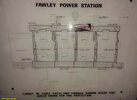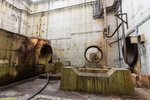The History
Fawley Power Station was an oil-fired power station located on the western side of Southampton Water, between the villages of Fawley and Calshot in Hampshire. Its 198 m (650 feet) chimney is a prominent (and navigationally useful) landmark, but it is not, as is sometimes claimed, the highest point in Hampshire (which is Pilot Hill).
The station, which in its final years was owned and operated by Npower, was oil-fired, powered by heavy fuel oil. A pipeline connected the station to the nearby Fawley oil refinery. Because oil is more expensive than other fuels such as coal and natural gas, Fawley did not operate continuously, but came on line at times of high demand.
It was also connected to the National Grid with circuits going to Nursling and a tunnel under Southampton Water to Chilling then to Lovedean with a local substation at Botley Wood.
A dock was included in the construction, to allow for the delivery of oil by sea; however after one ship-delivery (essentially a trial) this facility remained disused.
Fawley was built by Mitchell Construction for the CEGB and was commissioned in 1971 as a 2,000 megawatt (MW) power station, with four 500 MW generating units, each consisting of a boiler supplying steam to a turbine that powers an associated generator. It is interesting as the cooling pumps were Britain's largest with a flow of 210000 GPM. One was driven by an experimental super-conducting electric motor.
Two units were mothballed in 1995, leaving the station with a capacity of only 1,000 MW.
On 18 September 2012, RWE npower announced they would be shutting down Fawley power station by the end of March 2013, due to the EU Large Combustion Plant Directive. The power station was duly shut on 31 March 2013. The decommissioning and demolition of the plant is expected to take several years, and the future of the site remains undecided.
The Explore
Best laid plans of mice and men, or maybe mice and explorers…..
So the plan was for myself, @slayaaaa, @jonesy and @Disco Kitten to be up at the crack of dawn, Lucky Dawn eh, and to hit this in the dark and get inside before sun up. After all everything we had read said it was dodgy in the day light.
Well back to those plans…..
A late late night the night before meant we all managed to sleep through our alarms and eventually be up and ready around 10:30 and to meet up with one of the @WildBoyz a fair bit later than planned lol
Hmmm shall we go have a look anyways?
So we jumped in the cars and headed out to Fawley

After an initial wander down the coast which involved the stoking of many fellow walkers dogs we spotted an entrance and made our way in, with what can only be described as a loooooong run for a 42 year old man who eats too many takeaways lol
Once we arrived at the main building we simply slipped under the heras and made our way in. Once inside we found what appeared to be a huge amount of destruction. Turbines chopped in half, Turbine rotors all stripped out and a mass of gas axing going on. They are stripping out the turbine hall and getting a fair lick on with it.
We made our way up to get some snaps from the top of one of the cranes. These pics show the shear amount of work that’s already gone on there



















Once we had finished poncing about inside the turbine hall we made our way outside onto the roof, mainly to look for any security but also to check out the epic array of windows







Fawley Power Station was an oil-fired power station located on the western side of Southampton Water, between the villages of Fawley and Calshot in Hampshire. Its 198 m (650 feet) chimney is a prominent (and navigationally useful) landmark, but it is not, as is sometimes claimed, the highest point in Hampshire (which is Pilot Hill).
The station, which in its final years was owned and operated by Npower, was oil-fired, powered by heavy fuel oil. A pipeline connected the station to the nearby Fawley oil refinery. Because oil is more expensive than other fuels such as coal and natural gas, Fawley did not operate continuously, but came on line at times of high demand.
It was also connected to the National Grid with circuits going to Nursling and a tunnel under Southampton Water to Chilling then to Lovedean with a local substation at Botley Wood.
A dock was included in the construction, to allow for the delivery of oil by sea; however after one ship-delivery (essentially a trial) this facility remained disused.
Fawley was built by Mitchell Construction for the CEGB and was commissioned in 1971 as a 2,000 megawatt (MW) power station, with four 500 MW generating units, each consisting of a boiler supplying steam to a turbine that powers an associated generator. It is interesting as the cooling pumps were Britain's largest with a flow of 210000 GPM. One was driven by an experimental super-conducting electric motor.
Two units were mothballed in 1995, leaving the station with a capacity of only 1,000 MW.
On 18 September 2012, RWE npower announced they would be shutting down Fawley power station by the end of March 2013, due to the EU Large Combustion Plant Directive. The power station was duly shut on 31 March 2013. The decommissioning and demolition of the plant is expected to take several years, and the future of the site remains undecided.
The Explore
Best laid plans of mice and men, or maybe mice and explorers…..
So the plan was for myself, @slayaaaa, @jonesy and @Disco Kitten to be up at the crack of dawn, Lucky Dawn eh, and to hit this in the dark and get inside before sun up. After all everything we had read said it was dodgy in the day light.
Well back to those plans…..
A late late night the night before meant we all managed to sleep through our alarms and eventually be up and ready around 10:30 and to meet up with one of the @WildBoyz a fair bit later than planned lol
Hmmm shall we go have a look anyways?
So we jumped in the cars and headed out to Fawley

After an initial wander down the coast which involved the stoking of many fellow walkers dogs we spotted an entrance and made our way in, with what can only be described as a loooooong run for a 42 year old man who eats too many takeaways lol
Once we arrived at the main building we simply slipped under the heras and made our way in. Once inside we found what appeared to be a huge amount of destruction. Turbines chopped in half, Turbine rotors all stripped out and a mass of gas axing going on. They are stripping out the turbine hall and getting a fair lick on with it.
We made our way up to get some snaps from the top of one of the cranes. These pics show the shear amount of work that’s already gone on there



















Once we had finished poncing about inside the turbine hall we made our way outside onto the roof, mainly to look for any security but also to check out the epic array of windows































